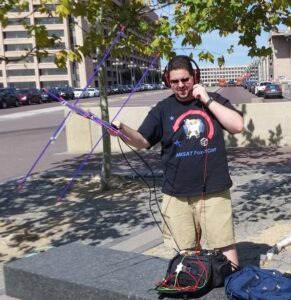Paul Stoetzer, N8HM, Executive Vice President

Happy New Year! 2020 promises to be an exciting year filled with new satellites to work and significant progress towards our next generation of satellites. By the time you read this, HuskySat-1 should be in orbit and completing its science mission before being turned over to AMSAT for amateur radio use. I want to congratulate all those involved with this project both at the University of Washington and on AMSAT’s Engineering and Operations teams who worked to make this mutually beneficial partnership happen. More details about HuskySat-1 and our partnership with the Husky Satellite Lab at the University of Washington can be found elsewhere in the January/February 2020 issue of The AMSAT Journal.
While we look forward to the completion of HuskySat-1’s primary mission, we also await the launch of the final Fox-1 satellite, RadFxSat-2 / Fox-1E, which is currently scheduled to launch no earlier than the first quarter of this year on the ELaNa XX mission. The ELaNa XX mission will fly on the second flight of Virgin Orbit’s LauncherOne vehicle.
As the Fox project wraps up its series of five 1U CubeSats, progress continues on GOLF, the next generation of AMSAT satellites. A group of GOLF-TEE (Greater Orbit Larger Footprint – Technology Evaluation Environment) satellite prototype boards transmitted telemetry for the first time on Tuesday, January 14th. During the test, the boards were laid out on a bench as a “flat-sat” with interconnecting wires, bench power supplies, and a dummy load on the transmitter. The interconnected boards included:
• An early RT-IHU (Radiation Tolerant Internal Housekeeping Unit – i.e., computer) prototype,
• A CIU (Control Interface Unit) prototype, and
• A set of spare boards from HuskySat-1 that act as prototypes for the LIHU (Legacy IHU) and legacy VHF/UHF RF components.
Now that the team has reached this point, AMSAT Engineering has RF to use as a basis for developing a GOLF-TEE decoder for FoxTelem, our ground telemetry receiver software. Thousands of hours of work by many AMSAT volunteers have gone into the hardware and software that got us this far, with much work yet to be done before the assembly of flight units. The GOLF-TEE satellite is designed as a Low Earth Orbit (LEO) testbed for technologies necessary for a successful CubeSat mission to a wide variety of orbits, including MEO (Medium Earth Orbit) and HEO (High Earth Orbit).
The work on GOLF is intended for our CubeSat missions to higher orbits. However, much as the Fox-1E linear transponder was adapted as a payload for HuskySat-1, components developed for GOLF, such as the RT-IHU and the microwave SDR transponder, can be adapted to serve as the basis for a hosted payload on a commercial or government satellite in geostationary orbit or perhaps an educational CubeSat destined for MEO or GTO. Should an opportunity arise, the work being done on GOLF means that we will be ready to build such a hosted payload.
While we continue our work on these satellites, we face the prospect of regulatory roadblocks. Last year, we submitted comments on the Federal Communication Commission’s Notice of Proposed Rulemaking regarding the mitigation of orbital debris. The proposed rules as worded would severely limit the type of missions AMSAT could pursue. While the Commission has not yet issued final rules, we are hopeful that the near-unanimous opposition of commenters to the more harmful aspects of the rules, such as the requirement for satellite operators to indemnify the United States Government for any potential claims regarding their satellites, will limit the negative impact.
Another serious concern is our access to spectrum. While international threats that arose in the months before the 2019 World Radiocommunication Conference to the 144 MHz – 146 MHz and 1260 MHz – 1270 MHz amateur satellite service bands have subsided for the time being, other threats appear on the horizon. This past December, the FCC issued a Notice of Proposed Rulemaking that would delete the amateur allocation at 3.3 GHz – 3.5 GHz, including the amateur satellite service allocation at 3.4 GHz – 3.41 GHz. While that band has not yet been used for any amateur satellites as it is not available in ITU Region 3 (Asia & Oceania), it is still a potentially useful resource for a future amateur geostationary payload over the Americas.
Additionally, we know that many AMSAT members also use this band for other purposes, such as mesh networking, contesting, and EME communications. Access to microwave spectrum is crucial for many of our planned activities, including GOLF and amateur radio on the Lunar Gateway, and we must vigorously defend our spectrum allocations. AMSAT is currently drafting comments opposing this proposed rule, and, working alongside the ARRL, we continue to monitor potential legislative and regulatory actions that could limit or even preclude some of our current and planned activities.
On a final note, I wanted to let the membership know that AMSAT’s servers will be migrating to a new operating system and a new hosting service later this year. This is necessary as the operating system currently running AMSAT’s servers will reach its end of life in November. While AMSAT’s capable IT team led by Joe Fitzgerald, KM1P, will do their best to minimize any disruptions to AMSAT services, this type of transition can often result in unforeseen problems. Continue to monitor the AMSAT-BB and AMSAT’s Twitter and Facebook accounts for any updates.
